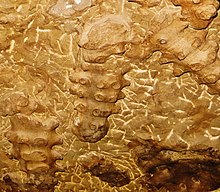Reticulosa is an extinct order of sea sponges in the class Hexactinellida (glass sponges) and the subclass Amphidiscophora.[1][2] Reticulosans were diverse in shape and size, similar to their modern relatives, the amphidiscosidans. Some were smooth and attached to a surface at a flat point, others were polyhedral or ornamented with nodes, many were covered in bristles, and a few were even suspended above the seabed by a rope-like anchor of braided glass spicules.[2][3]
| Reticulosa Temporal range:
| |
|---|---|

| |
| Fossils of Hydnoceras, a large dictyospongiid from the Upper Devonian | |
| Scientific classification | |
| Domain: | Eukaryota |
| Kingdom: | Animalia |
| Phylum: | Porifera |
| Class: | Hexactinellida |
| Subclass: | Amphidiscophora |
| Order: | †Reticulosa Reid, 1958 |
Reticulosans comprise the vast majority of Paleozoic hexactinellid diversity, though only a few species survived up to the Mesozoic.[2][3] They may include the oldest sponge body fossil in the world: Palaeophragmodictya, from the late Ediacaran (~555 Ma), was originally described as a reticulosan based on its mesh-like surface texture.[4] Ediacaran-type preservation has obscured any information about spicule structure, and some authors doubt that Palaeophragmodictya is a sponge in the first place.[5][6][7] Regardless, unambiguous reticulosans appear in the fossil record not much later, in the early Cambrian.[2]
Like most other glass sponges, reticulosans had a skeleton of unfused macroscleres reinforced with microscopic microscleres. Their macroscleres are often stauractines (four-rayed spicules, + shaped), though pentactine (five-rayed) or hexactine (six-rayed) spicules may be predominant in certain regions of the skeleton. The outer layer of the skeleton forms a regular mesh-like pattern, with incrementally smaller spicules filling in the gaps between larger spicules in a fractal pattern. The microscleres, when present, are simple bundled rods (paraclavules).[2][3]
The living glass sponge Sclerothamnus is sometimes compared to the reticulosan family Titusvillidae,[2][8] though it is more commonly placed in the family Tretodictyidae of the order Sceptrulophora.[9]
Subgroups edit
From the Treatise on Invertebrate Paleontology (2004), unless otherwise noted:[2]
- Superfamily †Dictyospongioidea Hall & Clarke, 1899
- Family †Dictyospongiidae Hall & Clarke, 1899 [Ediacaran?–Middle Permian (Roadian)]
- Family †Docodermatidae Finks, 1960 [Silurian (Ludlow)–Permian]
- Family †Stereodictyidae Finks, 1960 [Carboniferous (Visean)–Upper Triassic (Carnian)]
- Superfamily †Dierespongioidea Rigby & Gutschick, 1976
- Family †Aglithodictyidae Hall & Clarke, 1899 [Upper Devonian–Carboniferous (Visean)]
- Family †Amphispongiidae Rauff, 1894 [upper Silurian]
- Family †Dierespongiidae Rigby & Gutschick, 1976 [Middle Ordovician–Lower Permian (Artinskian)]
- Family †Hydnodictyidae Rigby, 1971 [middle Cambrian–Upper Ordovician]
- Family †Multivasculatidae Laubenfels, 1955 [upper Cambrian]
- Family †Titusvillidae Caster, 1939 [Upper Devonian–Lower Mississippian, Holocene?]
- Superfamily †Hintzespongioidea Finks, 1983
- Family †Hintzespongiidae Finks, 1983 [lower Cambrian–Middle Devonian (Givetian)]
- Family †Teganiidae Laubenfels, 1955 [upper Cambrian (Furongian)–Upper Mississippian]
- Superfamily †Protospongioidea Hinde, 1887
- Family †Asthenospongiidae? Botting, 2004[10] [Ordovician]
- Family †Protospongiidae Hinde, 1887 [lower Cambrian–Jurassic]
- Family †Triactinellidae? Botting, 2005[11] [Ordovician]
References edit
- ^ "Fossilworks: Reticulosa". fossilworks.org. Retrieved 17 December 2021.
- ^ a b c d e f g Treatise on Invertebrate Paleontology Part E, Revised. Porifera, Volume 3: Classes Demospongea, Hexactinellida, Heteractinida & Calcarea, xxxi + 872 p., 506 fig., 1 table, 2004, available here. ISBN 0-8137-3131-3.
- ^ a b c Treatise on Invertebrate Paleontology Part E, Revised. Porifera, Volume 2: Introduction to the Porifera, xxvii + 349 p., 135 fig., 10 tables, 2003, available here. ISBN 0-8137-3130-5.
- ^ Gehling, James G.; Rigby, J. Keith (March 1996). "Long expected sponges from the Neoproterozoic Ediacara fauna of South Australia". Journal of Paleontology. 70 (2): 185–195. doi:10.1017/S0022336000023283. ISSN 0022-3360.
- ^ Serezhnikova, E. A. (2007). "Palaeophragmodictya spinosa sp. nov., a bilateral benthic organism from the Vendian of the Southeastern White Sea Region". Paleontological Journal. 41 (4): 360–369. doi:10.1134/S0031030107040028. ISSN 0031-0301.
- ^ Antcliffe, Jonathan B.; Callow, Richard H. T.; Brasier, Martin D. (2014). "Giving the early fossil record of sponges a squeeze: The early fossil record of sponges". Biological Reviews. 89 (4): 972–1004. doi:10.1111/brv.12090.
- ^ Cunningham, John A.; Liu, Alexander G.; Bengtson, Stefan; Donoghue, Philip C. J. (2017). "The origin of animals: Can molecular clocks and the fossil record be reconciled?". BioEssays. 39 (1): e201600120. doi:10.1002/bies.201600120.
- ^ Burr, Sande A.; Chiment, John J.; Allmon, Warren D.; Rigby, J. Keith (2003). "A Problematic Fossil Brings Paleontology to the Classroom and the World". Journal of Geoscience Education. 51 (4): 361–364. doi:10.5408/1089-9995-51.4.361. ISSN 1089-9995.
- ^ Reid, R.E.H. (1961). "Notes on Hexactinellid sponges—III. Seven Hexactinosa". Annals and Magazine of Natural History. 4 (48): 739–747. doi:10.1080/00222936108651201. ISSN 0374-5481.
- ^ Botting, Joseph P. (2004). "An exceptional caradoc sponge fauna from the llanfawr quarries, central wales and phylogenetic implications". Journal of Systematic Palaeontology. 2 (1): 31–63. doi:10.1017/S147720190300110X. ISSN 1477-2019.
- ^ Botting, Joseph P. (2005). "EXCEPTIONALLY WELL-PRESERVED MIDDLE ORDOVICIAN SPONGES FROM THE LLANDEGLEY ROCKS LAGERSTATTE, WALES". Palaeontology. 48 (3): 577–617. doi:10.1111/j.1475-4983.2005.00470.x. ISSN 0031-0239.